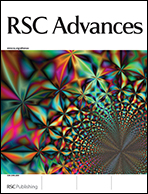Synthesis, structural characterization and anion-, cation- and solvent-induced tuning of photophysical properties of a bimetallic Ru(ii) complex: combined experimental and DFT/TDDFT investigation†
Abstract
A mixed-ligand bimetallic ruthenium(II) complex of composition [(bpy)2Ru(H2PyImPhen)Ru(bpy)2](ClO4)4 (1), where H2PyImPhen = 2,6-di(1H-imidazo[4,5-f][1,10]phenanthrolin-2-yl)pyridine and bpy = 2,2′-bipyridine has been synthesized and characterized using standard analytical and spectroscopic techniques. The X-ray crystal structure of its N–H deprotonated form (2) has been determined which showed that the compound crystallized in monoclinic form with the space group P21/c. The optimized geometrical parameters for the complexes computed both in the gas phase and in solution are reported and compared with the available X-ray data. The absorption spectra, redox behavior and luminescence properties of the complexes were thoroughly investigated. Complex 1 displays strong luminescence at room temperature with lifetimes in the range of 160–500 ns (aerated condition), depending upon the nature of the solvent. The complex is found to undergo one reversible oxidation in the positive potential window and three successive quasi-reversible reductions in the negative potential window. Both the anion and cation binding properties of 1 were thoroughly investigated in acetonitrile solution using absorption, steady state and time-resolved emission spectral studies. The anion sensing studies revealed that the receptor acts as a sensor for F−, AcO− and H2PO4−. It is evident that in the presence of excess F− and AcO− ion, deprotonation of the imidazole N–H fragments of 1 occurs. Anion-induced lifetime quenching by F− and AcO− and enhancement by H2PO4−, makes the receptor 1 a suitable lifetime-based sensor for selective anions. Coordination of metal ions such as Mn2+, Co2+, Cu2+ to the secondary coordination sphere of 1 trigger emission quenching, while metal ions having a completely filled d orbital (such as Zn2+, Cd2+ or Hg2+) do not quench; rather some finite enhancement of the fluorescence intensity of the receptor occurs. Density functional theory (DFT) and time-dependent DFT (TD-DFT) study provides insight into the nature of the ground and the excited states involved in absorption and emission transitions. In particular, the changes in the absorption and emission spectral characteristics of 1 on interaction with anions and cations are also reproduced by our calculations.


 Please wait while we load your content...
Please wait while we load your content...